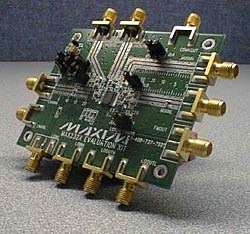Rapid engineering prototypes are actual circuits that Maxim application engineers build in the lab and conduct product testing. They are the starting point for new RF engineering designs. They are not intended to be used as assessment testing tools.

Objective: To develop an application circuit and verify the performance of this CDMA dual-band three-mode front-end IC in TDMA applications without using additional or special components to prove its performance.
The MAX2321 was originally developed for the growing IS-95 CDMA market, and it was quickly discovered that it also had excellent performance in TDMA IS-136 applications. This application circuit was designed to demonstrate the performance of the MAX2321 in IS-136. The conclusion is that it exceeds the target specification requirements in all test areas. The reported measurement results are provided in the text.
This design reflects the improvements in NF, gain and IIP3 performance of the new improved version compared to its predecessor as a cellular and PCS mixer.
The MAX2321 low-noise amplifier (LNA) mixer is designed for dual-band CDMA cellular handsets. It can also be used in dual-band TDMA, GSM, EDGE, or WCDMA applications. It provides two LNA gain states to meet CDMA dynamic range requirements, with switching hysteresis margin between the two states. The MAX2321 has three mixers: one for the analog cellular channels and two for digital modulation channels in the cellular and PCS bands. The digital channel mixer outputs a universal IF and provides sufficient rejection of spurious and image interference, eliminating the need for IF filters. The MAX2321 features separate, buffered VCO inputs and outputs in the cellular and PCS bands, eliminating the need for additional transmit upconverter VCO buffers. The cellular band VCO input provides an optional X2 multiplier allowing dual-band operation with a single VCO.
Application circuit of MAX2321 (PDF, 52kB)
Schematic of MAX2321 evaluation kit (PDF, 41kB)
PCS mixer IIP3 and gain measurement
PCS mixer noise figure
Cellular mixer IIP3 and gain measurement
PCS LNA noise figure
All reference designs on this site are sourced from major semiconductor manufacturers or collected online for learning and research. The copyright belongs to the semiconductor manufacturer or the original author. If you believe that the reference design of this site infringes upon your relevant rights and interests, please send us a rights notice. As a neutral platform service provider, we will take measures to delete the relevant content in accordance with relevant laws after receiving the relevant notice from the rights holder. Please send relevant notifications to email: bbs_service@eeworld.com.cn.
It is your responsibility to test the circuit yourself and determine its suitability for you. EEWorld will not be liable for direct, indirect, special, incidental, consequential or punitive damages arising from any cause or anything connected to any reference design used.
Supported by EEWorld Datasheet